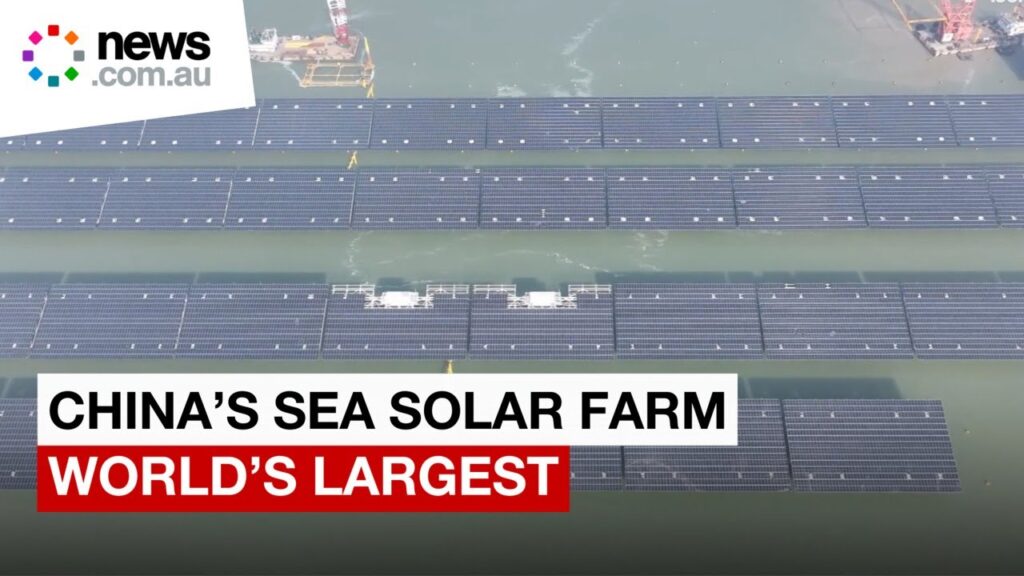China Opens World’s Largest Offshore Solar Power Facility
ENERGY, 18 Nov 2024
Juan Cole | Informed Comment - TRANSCEND Media Service
15 Nov 2024 – Solar panels are great sources of energy. We have them on our roof and they have saved us a lot of money, especially in spring-summer-fall. Some observers complain about their bulk compared to the energy they put out, though. I’ve had engineers argue to me that there just isn’t space for all the solar panels that would be needed to green the US energy grid.
Since I study the Middle East, I’ve had to learn about energy markets and security. One time about a decade ago I was doing some energy consulting with the Japanese Ministry of Economy, Trade and Industry (METI). Japan had had to deal with the closure of many of its nuclear plants after the Fukushima disaster by importing Liquefied Natural Gas (LNG) from the Middle East. They were nervous about the security of the region, though. I told my Japanese colleagues that they would be better off going in for wind and solar. One replied that Japan had very little land available for solar farms. I don’t know how sincere this reply was. I think those bureaucrats were just wedded to nuclear power. In fact, Japan now has over 87 gigawatts of solar power. It has been adding about 6 gigs of solar a year recently.
One solution to this problem that is increasingly being tried out is agrovoltaics, putting solar panels on farms but in such a way that they help crops grow. So far in the US, most agrovoltaic set-ups are for sheep raising, since grass can grow under the panels. In fact, the panels help the grass thrive in hot, sunny environments by providing shade and allowing retention of moisture, which is also good for “tomatoes, turnips, carrots, squash, beets, lettuce, kale, chard, and peppers.”
Solar panels are rapidly becoming more efficient, which will allow this form of energy to produce electricity while taking up less space.
In the meantime, another possible solution is to put the solar panels on floating platforms. Japan has put them on lakes, for instance.
The panel arrays can also be placed offshore. Fish and other marine life like structures such as the steel truss platform piling used for China’s offshore solar farms. It gives them places to hide from predators, e.g.
China is the most advanced solar society in the world with over 600 gigawatts of installed solar capacity, which saves the country billions of dollars a year over paying for imported fossil gas. The US is in comparison backward, only having about 130 GW of solar.
It is therefore no surprise that Beijing has, as Aman Tripathi reports, just connected to high capacity transmission wires the world’s large offshore solar plant off the coast of Shandong Province, a 1-gigawatt facility. The facility also does fish farming.
The nearly 3,000 photovoltaic platforms are attached to fixed pilings in the sea floor and are spread over an area of some 4 square miles. It will generate enough power to provide electricity to 2.6 million people.
And this installation is only the beginning. China is aiming to have 60 gigawatts of offshore solar in only 3 years from now — an incredible build-out if it happens.
China also already has 61 gigawatts of offshore wind capacity.
Wind, water, solar and battery are clearly the way forward on meeting the world’s power needs while avoiding massive carbon pollution. Solar plus battery in my view has the greatest potential over the medium to long term. The issue of where to put the PV panels is not in my view a very serious problem. If there is a will to use them to cut carbon dioxide production, as there is in China, then places will be found to put them — as China is demonstrating.
And by the way, if the US government under the incoming Trump administration puts roadblocks in the way of solar power, it will just accelerate US decline and help propel China further toward great power status. The future is solar panels and electric vehicles, and China is already eating our lunch on those two. If that goes on for a while, we’ll be poor, breathing dirty air, and paying trillions for climate catastrophes, while China replaces us as the world’s leading superpower.
***************
News.Com.Au : “China’s Massive 1-gigawatt Offshore Solar Cell Platform Now Connected To The Grid”
_____________________________________________
 Juan Cole is the founder and chief editor of Informed Comment. He is Richard P. Mitchell Professor of History at the University of Michigan and author of, among many other books, Muhammad: Prophet of Peace amid the Clash of Empires and The Rubaiyat of Omar Khayyam.
Juan Cole is the founder and chief editor of Informed Comment. He is Richard P. Mitchell Professor of History at the University of Michigan and author of, among many other books, Muhammad: Prophet of Peace amid the Clash of Empires and The Rubaiyat of Omar Khayyam.
Tags: China, Environment, Renewable Energy, Solar Energy
DISCLAIMER: The statements, views and opinions expressed in pieces republished here are solely those of the authors and do not necessarily represent those of TMS. In accordance with title 17 U.S.C. section 107, this material is distributed without profit to those who have expressed a prior interest in receiving the included information for research and educational purposes. TMS has no affiliation whatsoever with the originator of this article nor is TMS endorsed or sponsored by the originator. “GO TO ORIGINAL” links are provided as a convenience to our readers and allow for verification of authenticity. However, as originating pages are often updated by their originating host sites, the versions posted may not match the versions our readers view when clicking the “GO TO ORIGINAL” links. This site contains copyrighted material the use of which has not always been specifically authorized by the copyright owner. We are making such material available in our efforts to advance understanding of environmental, political, human rights, economic, democracy, scientific, and social justice issues, etc. We believe this constitutes a ‘fair use’ of any such copyrighted material as provided for in section 107 of the US Copyright Law. In accordance with Title 17 U.S.C. Section 107, the material on this site is distributed without profit to those who have expressed a prior interest in receiving the included information for research and educational purposes. For more information go to: http://www.law.cornell.edu/uscode/17/107.shtml. If you wish to use copyrighted material from this site for purposes of your own that go beyond ‘fair use’, you must obtain permission from the copyright owner.
Join the discussion!
We welcome debate and dissent, but personal — ad hominem — attacks (on authors, other users or any individual), abuse and defamatory language will not be tolerated. Nor will we tolerate attempts to deliberately disrupt discussions. We aim to maintain an inviting space to focus on intelligent interactions and debates.
